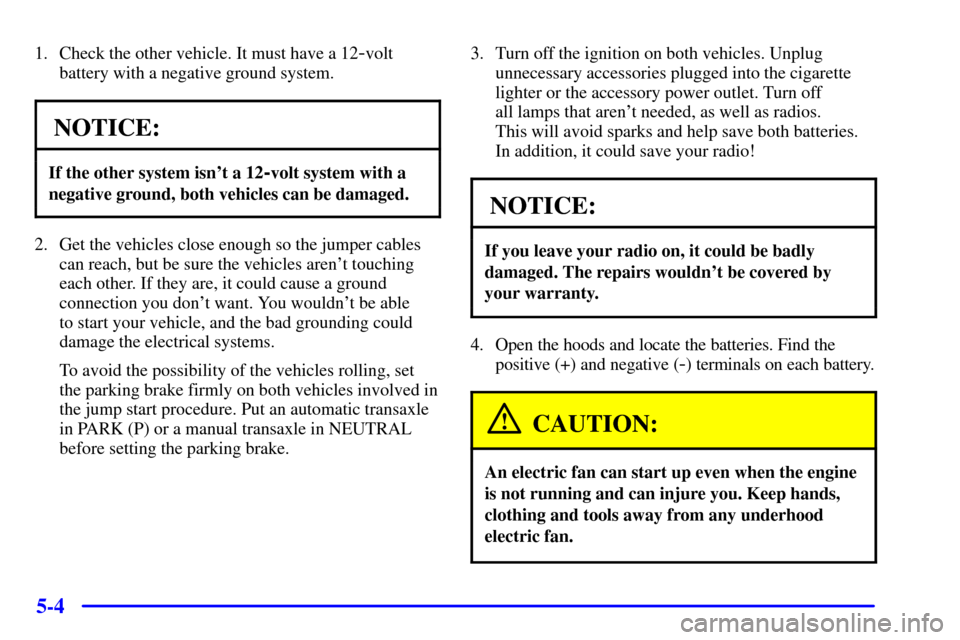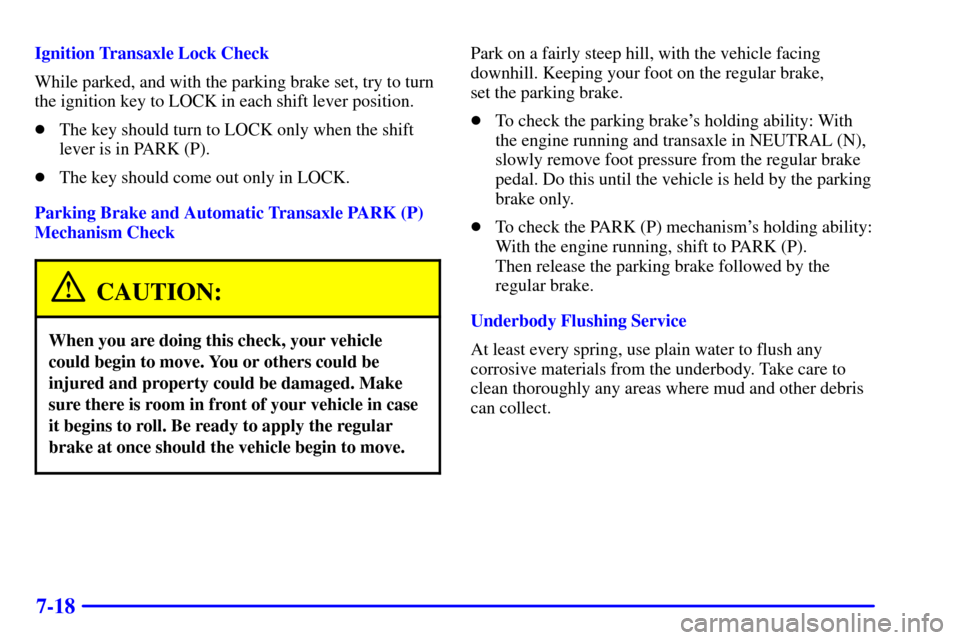Page 300 of 436

5-4
1. Check the other vehicle. It must have a 12-volt
battery with a negative ground system.
NOTICE:
If the other system isn't a 12-volt system with a
negative ground, both vehicles can be damaged.
2. Get the vehicles close enough so the jumper cables
can reach, but be sure the vehicles aren't touching
each other. If they are, it could cause a ground
connection you don't want. You wouldn't be able
to start your vehicle, and the bad grounding could
damage the electrical systems.
To avoid the possibility of the vehicles rolling, set
the parking brake firmly on both vehicles involved in
the jump start procedure. Put an automatic transaxle
in PARK (P) or a manual transaxle in NEUTRAL
before setting the parking brake.3. Turn off the ignition on both vehicles. Unplug
unnecessary accessories plugged into the cigarette
lighter or the accessory power outlet. Turn off
all lamps that aren't needed, as well as radios.
This will avoid sparks and help save both batteries.
In addition, it could save your radio!
NOTICE:
If you leave your radio on, it could be badly
damaged. The repairs wouldn't be covered by
your warranty.
4. Open the hoods and locate the batteries. Find the
positive (+) and negative (
-) terminals on each battery.
CAUTION:
An electric fan can start up even when the engine
is not running and can injure you. Keep hands,
clothing and tools away from any underhood
electric fan.
Page 345 of 436

6-16
How to Reset the Change Engine Oil Message
1. With the ignition key in RUN but the engine off,
repeatedly push the trip/reset button until OIL
is displayed.
2. Once OIL is displayed, push and hold the trip/reset
button for five seconds. The number will disappear
and be replaced by 100 (indicating 100% oil
life remaining).
3. Turn the key to OFF.
If the change engine oil message comes back on,
the engine oil life monitor has not reset.
Repeat the procedure.What to Do with Used Oil
Did you know that used engine oil contains certain
elements that may be unhealthy for your skin and could
even cause cancer? Don't let used oil stay on your skin
for very long. Clean your skin and nails with soap and
water, or a good hand cleaner. Wash or properly throw
away clothing or rags containing used engine oil.
See the manufacturer's warnings about the use and
disposal of oil products.
Used oil can be a real threat to the environment. If you
change your own oil, be sure to drain all free
-flowing
oil from the filter before disposal. Don't ever dispose of
oil by putting it in the trash, pouring it on the ground,
into sewers, or into streams or bodies of water. Instead,
recycle it by taking it to a place that collects used oil.
If you have a problem properly disposing of your used
oil, ask your dealer, a service station or a local recycling
center for help.
Page 370 of 436
6-41
To remove the wiper blade(s) do the following:
1. Turn the wipers on to the lowest intermittent setting.
2. Turn the ignition to OFF while the wipers are at the
outer positions of the wipe pattern. The blades are
more accessible for removal/replacement while in
this position.
3. Pull the windshield wiper arm away from the
windshield or backglass.
4. While holding the
wiper arm away from
the glass, push the
release clip from under
the blade.
5. Push the release clip at the connecting point of the
blade and the arm up and pull the blade assembly
down toward the glass to remove it from the
wiper arm.
6. Push the new wiper blade securely on the wiper arm
until you hear the release clip ªclickº into place.
7. Push the release clip, from Step 4, down to secure
the wiper blade into place.
Page 392 of 436
6-63
Circuit
BreakersUsage
1 Daytime Running Lamps (DRL)
Control Module, Headlamp and
Instrument Panel Dimmer Switch
2 Power Sliding Door
3 Front Power Windows
46
-Way Power Seats and Rear Side
Door Actuator Motor
5 Blower Motor Hi Speed
Relay ModuleFuses Usage
6 Steering Wheel Radio Control
Switches (Illumination)
7 Instrument Cluster to
PRNDL Indicators
8 Power Remote Control
Mirror Switch
9 Cruise Control Module,
Switch and Release Switch
10 Not Used
11 Powertrain Control Module (PCM),
Ignition Crank
12 PASS
-Key� III System
13 Body Control Module (BCM)
14 Heated Mirrors
15 Not Used
16 Not Used
17 Cigarette Lighter, Driver
Information Center (DIC),
Front Auxiliary Power Outlets
Page 396 of 436
6-67
Maxi Fuse Usage
5 IGN MAIN 1 Ignition Switch to Fuses
(Instrument Panel): ABS/TCS
IGN, CRUISE, DRL, ELEC
PRNDL, IGN 1, PSD, SIR,
T/SIG and PCM [IGN MAIN
Relay (Underhood Electrical
Center Fuses: A/C CLU, ELEK
IGN, IGN 1
-U/H, INJ, TCC)]
6 COOL FAN 1 Coolant Fans
7 BATT MAIN 1 Fuses (Instrument Panel): ABS
MOD BATT, CIGAR/DLC, CTSY
LAMP, FRT PWR SCKT, PWR
LOCK, PWR MIRROR and RR
PWR SCKT
8 IGN MAIN 2 Ignition Switch to Fuses (I/P):
BCM PRGRM, FRT HVAC
LOW/MED BLWR, FRT
WPR/WSHR, HVAC/DRL,
MALL/RADIO/DIC,
PWR QRT VENT, RR HVAC,
RR WPR/WSHR, SWC ACCY
and PWR WDO Circuit BreakerMini Relays Usage
9 COOL FAN RH FAN 1, LH FAN 2
10 COOL FAN 2 LH FAN 2
11 IGN MAIN FUSES: A/C CLU, IGN 1
-U/H,
INS, ELEK IGN, TCC
12 COOL FAN 1 RH FAN 1, LH FAN 2
Micro Relays Usage
13 A/C CLU A/C Clutch
14 FUEL PUMP Fuel Pump
15 Not Used
16 HORN Horn
17 FOG LAMP LH Fog Lamp, RH Fog Lamp,
Fog Lamp Indicator
Mini Fuse Usage
18 INJ Fuel Injectors 1
-6
19 SPARE Not Used
20 SPARE Not Used
Page 397 of 436

6-68
Mini Fuse Usage
21 IGN1
-UH Evaporative Emissions (EVAP)
Canister Purge Valve,
Heated Oxygen Sensors 1 and 2,
Mass Air Flow (MAF) Sensor
22 SPARE Not Used
23 SPARE Not Used
24 SPARE Not Used
25 ELEK IGN Ignition Control Module (ICM)
26 SPARE Not Used
27 B/U LAMP Transaxle Range Switch to
Back
-up Lamps
28 A/C CLU A/C CLU Relay to A/C
Compressor Clutch Oil
29 RADIO Driver Information Display,
Heater A/C Control, Radio,
Rear Side Door Actuator Control
Motor, Remote Control Door
Lock Receiver (RCDLR),
Security Indicator Lamp and
Theft
-Deterrent Shock SensorMini Fuse Usage
30 ALT SENSE Generator
31 TCC Automatic Transaxle (Torque
Converter Clutch Solenoids)
Stoplamp Switch to PCM
32 FUEL PUMP Fuel Pump Relay
33 ECM SENSE Powertrain Control Module (PCM)
34 Not Used
35 FOG LP Fog Lamp Relay
36 HORN Horn Relay
37 PARK LP Daytime Running Lamps (DRL)
Control Module, Headlamps and
Instrument Panel Dimmer Switch
Theft
-Deterrent Relay to Headlamps
38 Not Used
39 AIR Not Used
Diodes
A/C
CLU DIODE Air Conditioning Clutch Diode
40 Mini Fuse Puller
Page 417 of 436

7-18
Ignition Transaxle Lock Check
While parked, and with the parking brake set, try to turn
the ignition key to LOCK in each shift lever position.
�The key should turn to LOCK only when the shift
lever is in PARK (P).
�The key should come out only in LOCK.
Parking Brake and Automatic Transaxle PARK (P)
Mechanism Check
CAUTION:
When you are doing this check, your vehicle
could begin to move. You or others could be
injured and property could be damaged. Make
sure there is room in front of your vehicle in case
it begins to roll. Be ready to apply the regular
brake at once should the vehicle begin to move.
Park on a fairly steep hill, with the vehicle facing
downhill. Keeping your foot on the regular brake,
set the parking brake.
�To check the parking brake's holding ability: With
the engine running and transaxle in NEUTRAL (N),
slowly remove foot pressure from the regular brake
pedal. Do this until the vehicle is held by the parking
brake only.
�To check the PARK (P) mechanism's holding ability:
With the engine running, shift to PARK (P).
Then release the parking brake followed by the
regular brake.
Underbody Flushing Service
At least every spring, use plain water to flush any
corrosive materials from the underbody. Take care to
clean thoroughly any areas where mud and other debris
can collect.